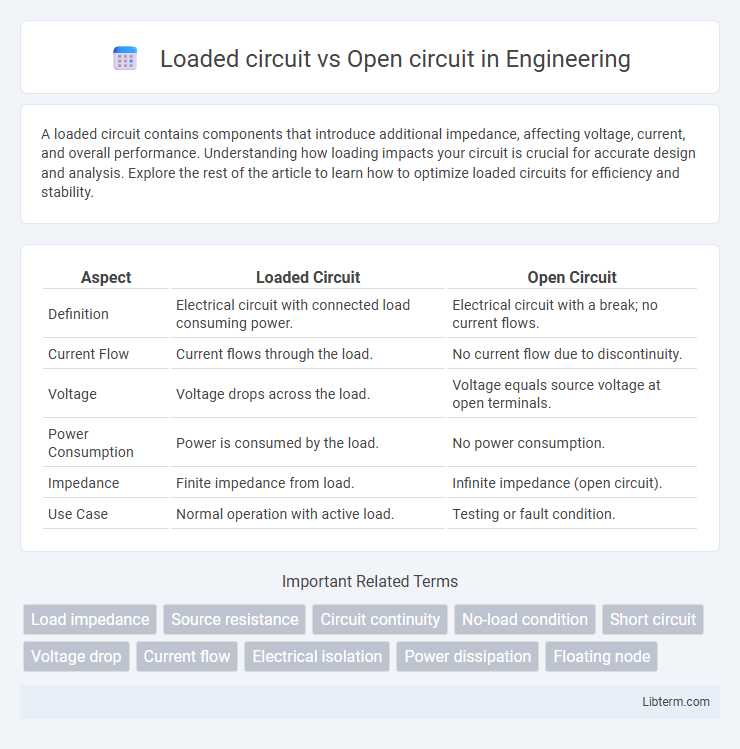A loaded circuit contains components that introduce additional impedance, affecting voltage, current, and overall performance. Understanding how loading impacts your circuit is crucial for accurate design and analysis. Explore the rest of the article to learn how to optimize loaded circuits for efficiency and stability.
Table of Comparison
| Aspect | Loaded Circuit | Open Circuit |
|---|---|---|
| Definition | Electrical circuit with connected load consuming power. | Electrical circuit with a break; no current flows. |
| Current Flow | Current flows through the load. | No current flow due to discontinuity. |
| Voltage | Voltage drops across the load. | Voltage equals source voltage at open terminals. |
| Power Consumption | Power is consumed by the load. | No power consumption. |
| Impedance | Finite impedance from load. | Infinite impedance (open circuit). |
| Use Case | Normal operation with active load. | Testing or fault condition. |
Definition of Loaded Circuit
A loaded circuit is an electrical circuit connected to a device or component that draws current, affecting the voltage and overall performance of the circuit. This contrasts with an open circuit, where there is a break preventing current flow, resulting in no current through the circuit. The presence of a load influences key parameters such as voltage drop, current flow, and power consumption in a loaded circuit.
Definition of Open Circuit
An open circuit is defined as a break or disconnection in an electrical circuit that stops current flow, resulting in zero current despite a potential difference across the circuit. Unlike a loaded circuit, where a load such as a resistor or device is connected to consume power, an open circuit lacks a continuous path for electrons, causing the circuit to be incomplete. This interruption in continuity makes an open circuit a fundamental concept for understanding circuit behavior and fault diagnosis.
Key Differences Between Loaded and Open Circuits
Loaded circuits feature components connected across the output, causing current flow and voltage drop, whereas open circuits have a break or gap preventing current flow entirely. In loaded circuits, the load determines the circuit's operational behavior and power consumption, while open circuits exhibit infinite resistance and no power delivery. Understanding these differences is crucial for analyzing circuit functionality and troubleshooting electrical systems effectively.
Electrical Flow in Loaded vs Open Circuits
In a loaded circuit, electrical flow is continuous as current passes through the connected load, allowing energy transfer and functional operation of devices. In contrast, an open circuit prevents electrical flow due to a break or disconnection, resulting in zero current and no power delivery to the load. The difference in electrical flow directly impacts circuit performance, with loaded circuits enabling active current pathways and open circuits creating interruptions that halt current movement.
Common Examples of Loaded Circuits
Loaded circuits typically involve components like resistors, capacitors, and inductors connected to a power source, enabling current flow and energy transfer, such as in household appliances or electronic devices. Common examples include a light bulb connected to a battery, where the bulb acts as a load consuming electrical power, or a radio circuit utilizing resistors and capacitors to process signals. In contrast, open circuits have breaks or gaps preventing current flow, exemplified by a disconnected wire or a switch in the off position.
Common Examples of Open Circuits
Common examples of open circuits include a broken wire in a flashlight, a switch in the off position, and a loose connection in an electrical outlet. These disruptions prevent current from flowing, causing devices like lamps and motors to stop functioning. In contrast, loaded circuits contain components such as resistors or appliances connected properly, allowing current to flow and work to be performed.
Effects on Voltage and Current
In a loaded circuit, voltage drops across the load causing current to flow according to Ohm's law, whereas in an open circuit, voltage is present but current is zero due to the break in the path. The loaded circuit experiences voltage division and power dissipation, impacting the voltage available at different points. Open circuits result in no current flow, preventing power transfer and maintaining full source voltage across the open terminals.
Practical Applications of Loaded Circuits
Loaded circuits, where a load is connected to the output of a source, are essential in practical applications such as power delivery systems, signal processing, and electronic devices because they accurately represent real operating conditions. Unlike open circuits, which have infinite impedance and no current flow, loaded circuits enable the analysis of voltage regulation, power consumption, and the impact of load variations on circuit performance. Common uses include battery-powered devices, audio amplifiers, and communication systems where maintaining consistent voltage and current under varying loads is critical.
Safety Considerations for Each Circuit Type
Loaded circuits contain active components and carry current under normal operation, requiring insulation and protective devices to prevent electrical shock and fire hazards. Open circuits have breaks preventing current flow, reducing immediate shock risk but potentially causing equipment malfunction and unsafe voltage buildup. Proper labeling and isolation are critical for both circuit types to ensure safe maintenance and prevent accidental energization.
Troubleshooting Loaded versus Open Circuits
Troubleshooting loaded circuits involves checking for voltage drops and ensuring current flows through components, indicating proper load functionality. Open circuits require identifying breaks or disconnections that prevent current flow, often using continuity tests or visual inspections. Accurate diagnosis depends on distinguishing voltage presence in loaded circuits versus absence in open circuits to pinpoint faults efficiently.
Loaded circuit Infographic

 libterm.com
libterm.com